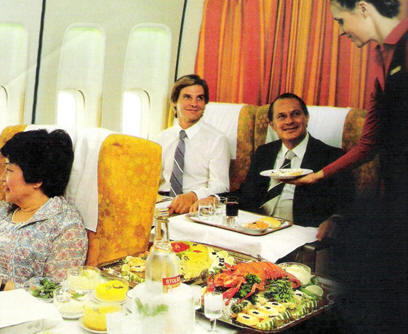|
|
20s | 30s | 40s | 50s | 60s | 70s | 80s | 90s | 2000s |
 |
|
|
||||||||||

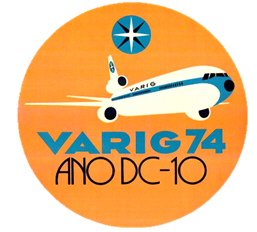
The 1970s became known as VARIG golden age, marked by jets greater presence in domestic routes and the arrival of the first wide-body aircraft. VARIG made major investments in its main base, Galeão International Airport in Rio de Janeiro, which was then inaugurated its new passenger terminal. VARIG created a training and maintenance center and began the construction of the largest hangar in Latin America.
In the domestic market VARIG brought Boeing 727 and Boeing 737, which replaced turbo-propellers on domestic routes. For the regional routes, VARIG brought the "Avros". The Electra II began to operate only in Rio de Janeiro - São Paulo route, known as “Ponte Aérea” (Air Bridge). From 1975 to 1987, Electra II was the only aircraft to operate this route.
The introduction of jets on domestic routes made travel much faster, reducing the average time by half. However, many regional cities were no longer served by scheduled flights, since it not support jets aircraft. Seeing this situation, the Brazilian government created SITAR (Regional Air Transport System) in 1976. Brazil was divided into five regions and new regional companies were created to operate in each region. VARIG and Top Táxi Aéreo joined forces to create Rio Sul on August 24, 1976. Rio Sul was responsible for serving the entire south region, as well as Rio de Janeiro, São Paulo and Espírito Santo states. Rio Sul was officially created on August 24, 1976 and began flights with two Embraer EMB-110s, in September of the same year, on Porto Alegre - Rio Grande - Pelotas and Rio de Janeiro - São José dos Campos routes.
In July, 1974 VARIG inaugurated the first wide-body flight with Douglas DC-10-30, the most modern and advanced jet of that time, on Rio de Janeiro - New York route. The DC-10-30 inaugurated a new era in international flights. The internal decoration followed the fashion of the time with shades of orange and yellow, the same colour of the new flight attendants uniform.
The 1970s were also marked by the expansion of flights to South America, after the purchase of Cruzeiro do Sul airline in 1975. Continuing its international expansion, VARIG launched flights to Africa in 1970, on Rio de Janeiro - Luanda - Johannesburg route. After purchase Cruzeiro, VARIG became the only Brazilian airline with international flights and reached more than 40% of domestic market share. Although it was full incorporated, Cruzeiro brand continued to exist until the 90s, and VARIG advertisements also started to feature Cruzeiro logo between the second half of the 1970s and the first half of the 1980s.
With the introduction of jets in the domestic market and the introduction of wide-body in the international market, the seats offer per aircraft has increased considerably. Allied to this, the aviation sector suffered the consequences of the "oil shock", which reduced passenger demand and increased costs. Thus, VARIG fleet was adjusted to this new reality, going from almost 100 aircraft to just over 60. The old turbo-propellers were replaced by jets, just as older jets were replaced by wide-bodies.
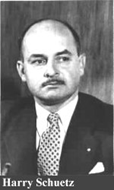 Also under
Erik Caravalho’s command, VARIG created the largest aeronautical
maintenance park in South America. However he had to leave the
company in 1979, due health problems. Harry Schuetz, one of the
oldest employees, continued Ruben Berta and Erik de Carvalho legacy.
However, just as his predecessor, Harry Schuetz was forced to be
away from office early next year.
Also under
Erik Caravalho’s command, VARIG created the largest aeronautical
maintenance park in South America. However he had to leave the
company in 1979, due health problems. Harry Schuetz, one of the
oldest employees, continued Ruben Berta and Erik de Carvalho legacy.
However, just as his predecessor, Harry Schuetz was forced to be
away from office early next year.
In late 70s VARIG was already the largest private company in
the world outside the USA, the eighth largest of the world in air
cargo, the fourteenth largest in lines length and twenty-second
in passenger/kilometers.
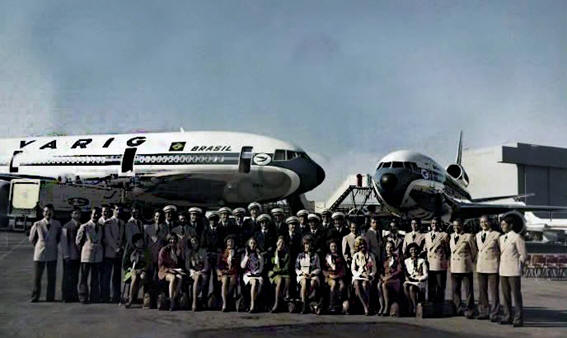
Ceremony to receive the first two Douglas DC-10-30
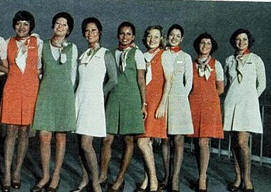
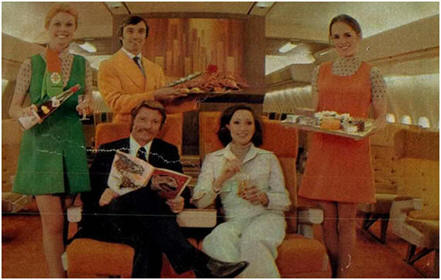
Crew Uniform - 70s /
VARIG’s DC-10-30 First Class


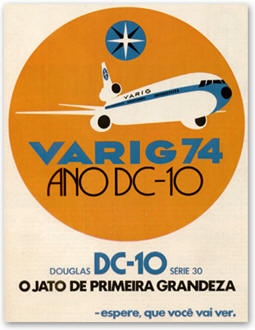

Advertisements in the 70's
 |
|
HOW WAS FLYING IN THE 1970s? In First Class, glamor was more present than ever with new large wide-body jets. With more space in the cabin, passengers could enjoy bars, rest rooms and meeting inside the plane. The main attraction still the meal, which was served on Japanese porcelain, crystal glass and silverware. The caviar was the great attraction on board VARIG’s First Class. Travel was an event and passengers were wearing their best suits and dresses. In economy class, meal ware served in porcelain, metal flatware and glass cup. And don’t forget the coffee and Swiss chocolate. In 1979 VARIG won the award for best in-flight service in the world by the prestigious American magazine Air Transport World.
The 1970s marked the transition from turbo-prop to jet on domestic flights. DC-3, Curtiss C-46, Convair and Constellation were replaced by Boeing 727-100 on main national routes. Only regional flights, served by "Avro", and RJ-SP "Air Bridge", served by Electra II, continued to be operated by turboprop aircraft. Flight time was reduced by half and this affected the on-board service. At that time, the on-board service was time-consuming, the meals were served in several stages. With the introduction of jets, there was not enough time and the whole process had to be remodeled to be faster. On short flights, for example from Recife to Natal, only drinks were served. But on longer flights, such as those connecting the northeast capitals to Rio de Janeiro and São Paulo, had full board service. The service began with the distribution of moistened wipes, soon after drinks and then two rounds of cold canapés. The next step were the hot canapés and mini barbecue and shrimp. Then the cold entrances, followed by the wine cart. Finally the main course, where one of the most famous was lobster medallion. Later it was dessert time, with candies, cakes, pies, ice cream and fruit. Soon afterwards came coffee, tea and digestives.
|
|
70s |
||
|
Fleet evolution (VARIG Group):

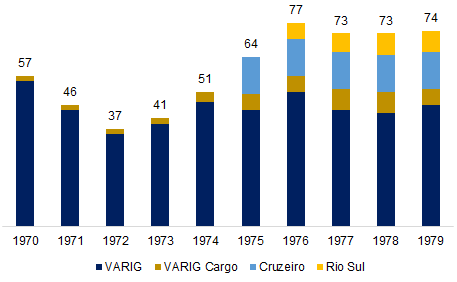


VARIG's international route map - 1971 / Passengers boarding on
Electra II


Boeing 727-100 / Boeing 737-200 and EMB-110 (Museu VARIG)
 |
|
FOCUS: On Electra II's Wings
Electra II was one of the
most famous aircraft models in Brazil and operated for
30 years without any accident. But many Brazilians don't
know that this same aircraft had tremendous bad
reputation in the United States, after several fatal
accidents. The Electra II was a flop worldwide, except
in Brazil. |






